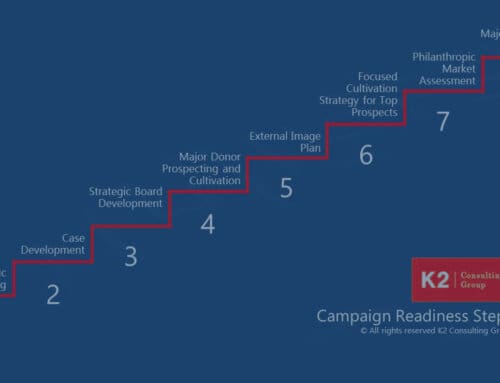Why is There So Much Turnover Among Development Officers – and What Can You Do About It?
PART II of III: How can you discern if this is the right position for you?
“Fit” is as much the candidate’s responsibility as it is the recruiter’s or hiring manager’s. A position may sound prestigious, or interesting, or a great next step in your career – but that doesn’t mean it’s the right position for you.
The chief development officer is a complex position requiring excellent planning, budgeting, hiring, management, presentation, sales (yes, sales), diplomatic, communication and listening skills. Engaging and relying on volunteers for fundraising is one thing that distinguishes the 501(c)3 from for-profits; it makes the nonprofit sector so rewarding — and challenging.
As you interview with the CEO, board members and other senior staff, consider asking these questions:
You, the Candidate
“What about my background and qualifications stood out as reasons why I might be the right fit for this position?”
The answer to this question helps you decide whether this position is the right fit for you. What is the CEO looking for? If revamping all of the internal systems is what is needed, and you are a person who thrives on donor engagement, consider carefully.
The Position: Is this the right Development Officer Position?
“Why is the position open? Is it a new position?”
Turnover doesn’t mean the position is not for you. Explore the root causes. Be straightforward in order to get an honest answer. An indirect answer can suggest possible patterns in people quitting or being released. If it’s open because of a promotion, great!
“What constitutes success in this position?”
Responses to this question can help you determine the organizational culture and CEO’s leadership style. Look for appreciation and understanding of the CDO role.
“What are some of the challenges in this position?”
Look for the CEO’s awareness and transparency about the challenges and how s/he would help mitigate them. Don’t be afraid to push for an answer as awkward as that might be.
“How will you measure success in the first 90 days? Six months? A year?”
Enter your employment agreement with goals and measurements defined in advance. Measurements can include dollars raised, volunteer engagement, prospect identification, systems, hiring, elevating expectations throughout the department and more. Make sure the CEO, the Development Committee and the Board are in agreement on the goals.
“Do you have any hesitations about my qualifications?”
Excellent question that a) demonstrates your self-confidence, b) gives you an idea of the CEO’s estimation of you and c) reveals gaps you might have to bridge.
“Is continuing education available?”
This shows you’re interested in growing in ways that will benefit your employer. The answer conveys the organization’s willingness to invest in your growth and available resources for continuing education.
The Board
“Is the board involved in achieving these measurements of success?”
If the board is not involved – red flag! You can’t raise funds alone; to think otherwise is a disservice to the organization. Avoid ending up in the “bad cop” role. Will the CEO join in engaging the board in development?
“Is the board ready for engagement in fundraising?”
If the board’s engagement is weak, ask who might serve as change agent to begin altering the board’s culture. Can you and the CEO develop a plan to engage the board?
“Is the board ready for engagement in the proposed campaign?”
This is information a consultant must ferret out as well. If the CEO has not engaged the board in planning and preparation for a campaign, you may be in for a real challenge.
“Are development goals part of the CEO’s success measurements? Could you share those with me?
This gives you a peek into the board’s expectations of the CEO. If other operations are the priority, will the CEO give appropriate attention to development?
“What have you discovered about the culture of philanthropy since assuming this position? Any surprises?”
Listen for the CEO’s breadth of development experience. Helping develop a culture of philanthropy can be a very rewarding experience if the CEO and board are ready.
The CEO’s Engagement in Fundraising
“What do you enjoy most about the CEO role?”
Look for enthusiasm, determination, and vision. The answer will indicate where they put time and attention. Can they be open and share a personal side with you? It might also turn the interview into more of a conversation.
“What do you enjoy most about fundraising? What areas would you like to improve?”
Look for self-awareness, comfort, and experience. The best leaders know that they don’t know everything and will be candid about their strengths and limitations. Willingness to call out their own shortcomings shows they can be vulnerable and will appreciate a transparent relationship.
“How much time are you able to devote to communicating with and visiting donors?”
Donor engagement is a key CEO responsibility. Determine comfort levels and aptitude. Not everyone is a born salesperson; skills can be developed through coaching.
“What is an ideal working relationship between you and your Chief Development Officer?”
Will this working relationship match your style? Drill down: how much direct access will you have to the CEO? Is there a dotted line to another senior leader? Don’t be surprised later.
“What is the best way for a newcomer to the organization to adjust to the organization’s culture?”
Excellent question, as many organizations view their culture as unique. Determine just what it takes to be a good fit.
Fundraising Capacity Indicators
“What indicators suggest that a $10M (whatever figure) is feasible for the proposed campaign? How has the readiness been determined?”
Use your experience and skills to conduct due diligence on any proposed campaign. Did a consultant determine the readiness? Was data collected? Or is the goal an unqualified guess? Ask for records and reports (you can always sign a confidentiality agreement).
“Does the organization have a strategic plan?”
Great fundraising emanates from a strategic plan; ask to see it if it’s not on the website. Does the plan reflect a vision that will enhance your ability to raise funds? Who participated in the planning, and what data suggests the plan is viable?
These questions may seem direct. They are not meant to put the CEO or anyone else on the spot. You want to make an honest evaluation of the organization’s goals and its development capacity – and of your fit as the organization’s development leader.
By sharing and addressing your concerns upfront and agreeing on goals and priorities, you will increase your odds of thriving and enjoying your new position – consider walking away if you do not.
Reach beyond the CEO for the answers: insist on interviewing one-on-one with board members and asking similar questions since you have a mutual stake in the organization’s success.
Such requests should be readily granted. Smart organizations are willing to be transparent, self-aware, and patient in order to find the right candidate, prevent turnover, steward resources, and create a thriving environment for philanthropy. Those are the ones you want to work for.
Proceed to Part III of our three-part blog: What I look for when hiring development professionals to ensure the right fit.
Ready to get started on reaching your potential? Contact us to get started.







